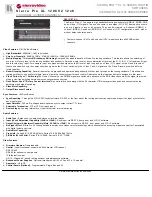
27
Configuring a distributed VXLAN IP gateway
Configuration restrictions and guidelines
Make sure a VSI interface uses the same MAC address to provide service on distributed VXLAN IP
gateways connected to IPv4 sites. Make sure a VSI interface uses different link-local addresses to
provide service on distributed VXLAN IP gateways connected to both IPv4 and IPv6 sites.
If both ARP flood suppression and local proxy ARP are enabled on a distributed VXLAN IP gateway,
only local proxy ARP takes effect. As a best practice, do not use these features together on
distributed VXLAN IP gateways. For more information about ARP flood suppression, see "
."
Configuration prerequisites
For a VXLAN that requires access to the external network, configure a static route to specify the
VXLAN's VSI interface on the border gateway as the next hop.
Configuration procedure
Step Command
Remarks
1.
Enter system view.
system-view
N/A
2.
Create a VSI interface
and enter VSI interface
view.
interface vsi-interface
vsi-interface-id
By default, no VSI interfaces exist.
3.
Assign an IPv4 or IPv6
address to the VSI
interface.
•
Assign an IPv4
address:
ip
address
ip-address
{
mask
|
mask-length
}
[
sub
]
•
Assign an IPv6
address:
See IPv6 basics in
Layer 3—IP Services
Configuration Guide
.
By default, no IPv4 or IPv6 address is
assigned to a VSI interface.
This interface will be used as a gateway for
VXLANs.
4.
Specify the VSI
interface as a
distributed gateway.
distributed-gateway local
By default, a VSI interface is not a distributed
gateway.
5.
Enable local proxy ARP
or local ND proxy.
•
Enable local proxy ARP
on an IPv4 gateway:
local-proxy-arp
enable
[
ip-range
startIP
to
endIP
]
•
Enable local ND proxy
on an IPv6 gateway:
local-proxy-nd enable
By default, local proxy ARP and local ND
proxy are disabled.
For more information about the commands,
see
Layer 3—IP Services Command
Reference
.
6.
Return to system view.
quit
N/A
















































